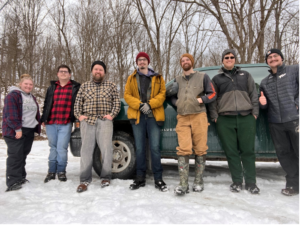A safe home for the five-lined skink

On March 5, the Castleton Backcountry Hunters and Anglers Club worked with the Vermont Fish and Wildlife Department to restore five-lined skink habitat. This project was part of the Public Land Owner Grant the Castleton University team was awarded. Funds were provided through the S. Kent Rockwell Foundation for BHA’s Collegiate Program.
The five-lined skink, a threatened species in Vermont, is the only lizard species in the state. Unfortunately, it is only reported to exist in a few towns in the state, as Vermont sits on the northernmost part of its range.
The project was created in a known habitat for the lizards that spend their winters in cracks along the cliff of Lake Champlain. This particular area is heavily shaded, mainly due to cedar trees that negatively affect the lizard’s ability to sun itself. Being a cold-blooded species, the five-lined skink needs to spend a part of its day warming itself in the sun to increase its body temperature or it risks dying.
The original goal of this project was to remove cedars along the cliff. This includes cutting them down and lowering them into the lake below to help various turtle species in Lake Champlain. The lowered trees would act as a sunning spot for turtles, increasing the project’s value.
However, this was unable to take place because the cedars along the cliff were bored at over 200 years old. When managing ecosystems, there is always a give and take: what benefits one species can harm another. A balance was met where cedars that were deemed unhealthy would be removed. Other species that were not significant in age were removed to allow needed sunlight to hit the forest floor.
This is where Castleton’s Backcountry Hunters and Anglers come into play. Members helped take the downed trees and turn them in to brush pile doing two things to help the five-lined skink. The first was removing the brush from potential sunning spots. The five-link skink is a small lizard, so it was essential to move even the smallest branch to allow the lizard the opportunity to get full sun.
The second benefit was creating a rodent hotel. This might seem gross or wrong to make a structure promoting rodents. However, this spot was a good hike into the woods, and I promise you no neighbors will get in a rodent infestation because of it. The brush piles provide the five-lined skink and many snake species, including those that are rare and threatened, a fantastic foraging buffet.
At one-point, while the piling brush, a bush plane flew through the narrow cliffs hovering just above the lake as they were working, making the experience even more beautiful and rewarding. Shortly after, we finished the project earlier than expected and were able to get a tree felling demo from one of the State Foresters. We enjoyed some hot chocolate and grilled up some venison burgers back at the parking lot to thank the volunteers who came out to help. Thanks to Luke Groff: Vermont Fish and Wildlife Herpetologist and Ethan Crumley: Vermont Forest, Parks, and Recreation Forester, for providing the opportunity for this project.
If you are interested in helping out in a future restoration project, the club will be doing another one on April 16 at the Gale Meadow Wildlife Management Area. We will be planting apple trees among other plants to increase food for wildlife.








